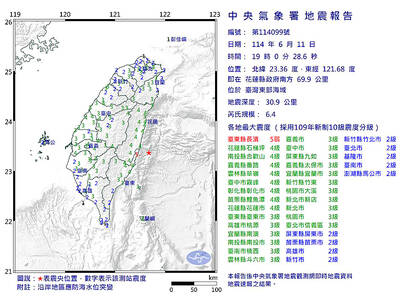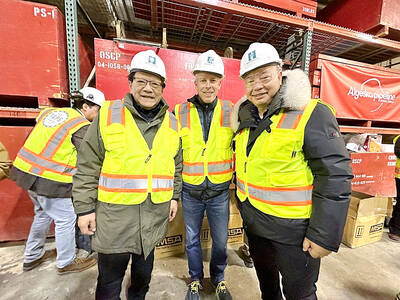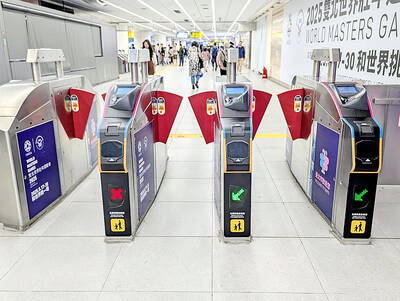Although law enforcement officers yesterday expressed concern about the increasing number of "self-voyeurs" on the Internet, women's rights activists looked at the issue from a different point of view.
Officers of the National Police Administration's Highway Police Bureau said that they recently received several pictures of nude women that were photographed on the highway.
The police yesterday showed pictures to the media of a naked woman, with the face and pubic area blurred, standing next to the highway. A big road sign of the Ching-shui Rest Area next to the highway is visible in the background on one of the pictures.

A police patrol car was also captured in the same picture, but the officers inside the patrol car apparently did not see the naked woman when they passed by. The highway police are now trying to trace the woman.
Officials said yesterday that they strongly suspected these pictures were the result of computer editing.
"Officers investigated the spot where the picture was taken. There should be a slight left turn in the road, but it was a slight right turn in the picture. We therefore strongly suspect that these pictures have been edited," said Kuo Kuo-ming (
Social critic Pu Ta-chung (
Josephine Ho (
"Actors and actresses also expose their bodies in front of cameras. So, why can't ordinary people do the same thing? We shouldn't just dismiss these pictures as pornography," Ho said.
The Taipei Times yesterday spoke to some college students, who agreed that "self-portrait nude pictures" was a form of self-expression. One of the students admitted to having taken nude pictures of himself.
"I did it for fun," said Joseph C, who is now a junior. "But I would not post the pictures on the Internet."
His classmate Alanis K said that it is just another way to deliver a message.
"I do not think the issue is worth a front-page story. Everybody has the right to deliver a message no matter what that is. No big deal," she said.

A magnitude 6.4 earthquake struck off the coast of Hualien County in eastern Taiwan at 7pm yesterday, the Central Weather Administration (CWA) said. The epicenter of the temblor was at sea, about 69.9km south of Hualien County Hall, at a depth of 30.9km, it said. There were no immediate reports of damage resulting from the quake. The earthquake’s intensity, which gauges the actual effect of a temblor, was highest in Taitung County’s Changbin Township (長濱), where it measured 5 on Taiwan’s seven-tier intensity scale. The quake also measured an intensity of 4 in Hualien, Nantou, Chiayi, Yunlin, Changhua and Miaoli counties, as well as

Credit departments of farmers’ and fishers’ associations blocked a total of more than NT$180 million (US$6.01 million) from being lost to scams last year, National Police Agency (NPA) data showed. The Agricultural Finance Agency (AFA) said last week that staff of farmers’ and fishers’ associations’ credit departments are required to implement fraud prevention measures when they serve clients at the counter. They would ask clients about personal financial management activities whenever they suspect there might be a fraud situation, and would immediately report the incident to local authorities, which would send police officers to the site to help, it said. NPA data showed

ENERGY RESILIENCE: Although Alaska is open for investments, Taiwan is sourcing its gas from the Middle East, and the sea routes carry risks, Ho Cheng-hui said US government officials’ high-profile reception of a Taiwanese representative at the Alaska Sustainable Energy Conference indicated the emergence of an Indo-Pacific energy resilience alliance, an academic said. Presidential Office Secretary-General Pan Men-an (潘孟安) attended the conference in Alaska on Thursday last week at the invitation of the US government. Pan visited oil and gas facilities with senior US officials, including US Secretary of the Interior Doug Burgum, US Secretary of Energy Chris Wright, Alaska Governor Mike Dunleavy and US Senator Daniel Sullivan. Pan attending the conference on behalf of President William Lai (賴清德) shows a significant elevation in diplomatic representation,

The Taipei MRT is to begin accepting mobile payment services in the fall, Taipei Rapid Transit Corp said on Saturday. When the company finishes the installation of new payment units at ticketing gates in October, MRT passengers can use credit cards, Apple Pay, Google Pay and Samsung Pay, the operator said. In addition, the MRT would also provide QR payment codes — which would be compatible with Line Pay, Jkopay, iPass Money, PXPay Plus, EasyWallet, iCash Pay, Taiwan Pay and Taishin Pay — to access the railway system. Currently, passengers can access the Taipei MRT by buying a single-journey token or using EasyCard,